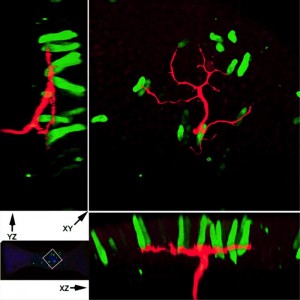
A single identified injected afferent axon (red) arbarizes in among vestibular sensory cells, making contact with multiple GABAergic hair cells (green)
(A) We are currently conducting studies of the chemoanatomy of functionally-distinct processing units in the peripheral sensory epithelia of the vestibular system. Physiologically characterized primary afferent fibers and sensory hair cells of differing morphology, connectivity, transmitter phenotype, and responsiveness to infrared stimulation are reconstructed and analyzed by confocal, multiphoton and electron microscopy. We are pursing the overall hypothesis that differences in hair cell phenotype and postsynaptic receptor populations shape the neural code conveyed to the brain by different classes of primary afferent fibers. These studies are particularly relevant to peripheral vestibular disorders such as Ménière’s Disease, and vestibular prosthetic devices that are currently in development and that require neural code precision.
(B) We are also conducting studies addressing the role of protonergic neurotransmission in conveying excitatory signals from some vestibular receptor cells to their postsynaptic partners – the terminals of vestibular nerve fibers.
[wds id=”1″]
